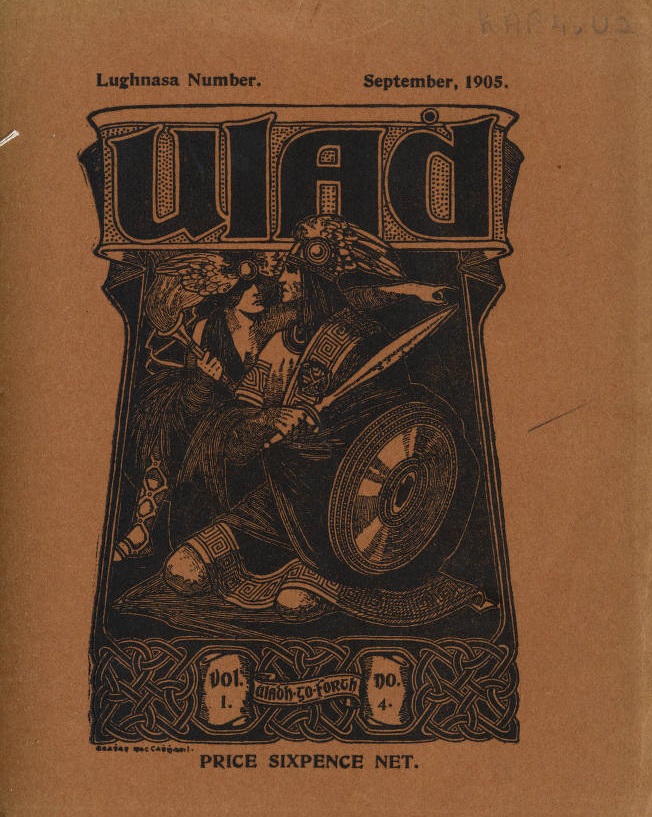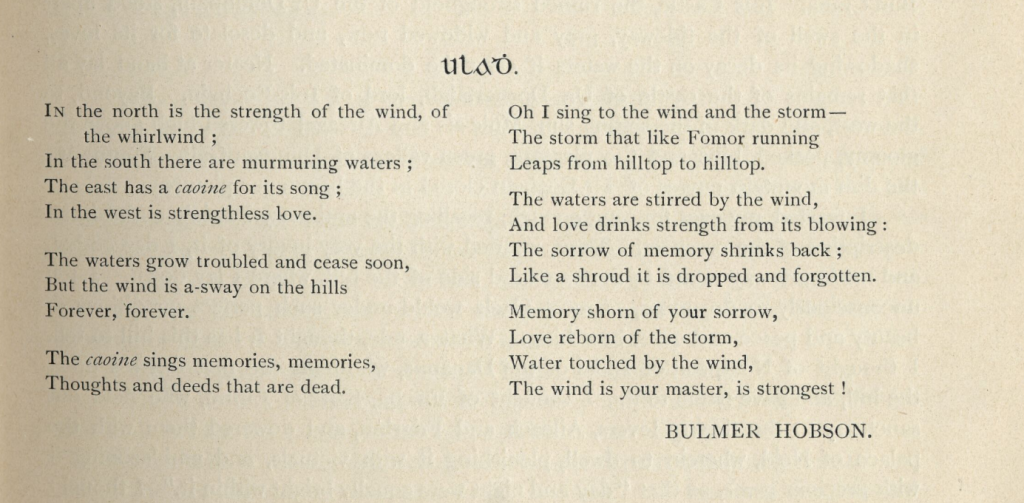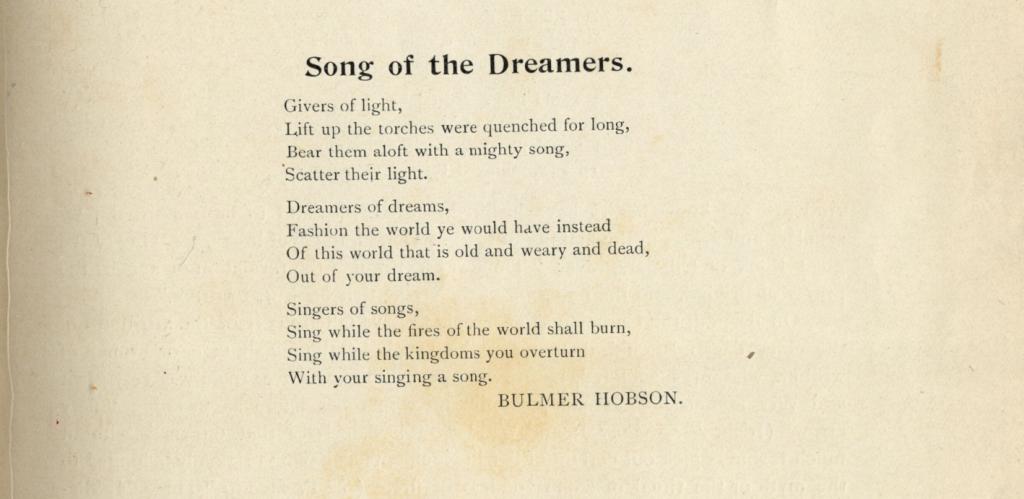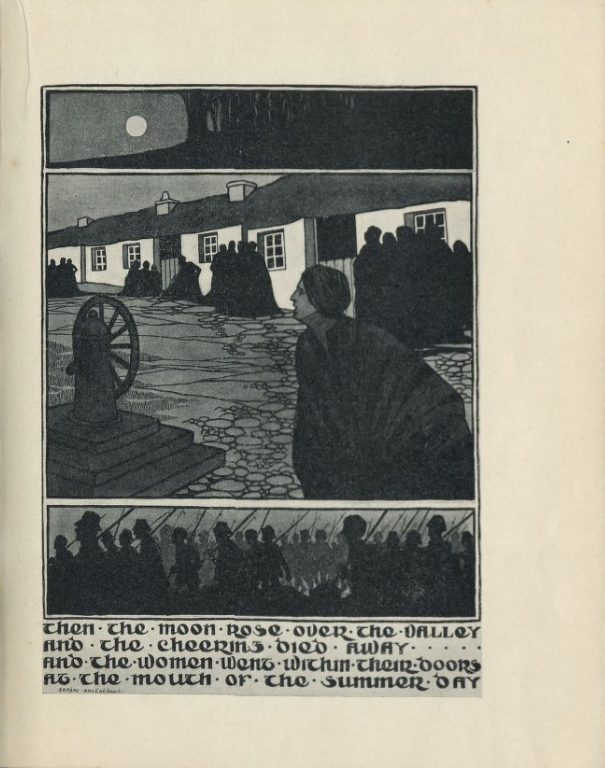Ulaḋ’s new dawn
Our latest blog entry comes courtesy of Charles Lang, PhD researcher at the Seamus Heaney centre at Queen’s and student assistant at Special Collections. All materials referred to here are held at Special Collections & Archives, Queen’s University Belfast. Ulaḋ is available for consultation in the Reading Room and each issue can read online via Digital Special Collections & Archives.

Ulaḋ: A Literary and Critical Magazine heralded itself with a certain force. Introducing its inaugural issue, its editor W.B. Reynolds states: “Ulaḋ means Ulster. It is still often necessary to state as much; […] This Ulster has its own way of things. […] We wish to locate this, and to afford it an outlet in literary expression.”[1] In spite of its grand objectives, the magazine was relatively short-lived, publishing only four issues from November 1904 to September 1905. Nonetheless, its impact was greater than its brevity might suggest. In his study The Ulster Literary Theatre and the Northern Revival, Eugene McNulty writes that Ulaḋ made “a major contribution to the task of giving a voice to (nationalist) Ulster, a voice that spoke to the rest of Ireland but also spoke to Ulster itself.”[2]
The magazine was borne out of the Ulster Literary Theatre (ULT), which was founded in Belfast in 1904 with the aim to reimagine the northern cultural focus and form a conscious movement away from what was seen to be the dominance of Leinster. Rooted in Ulster, founding members Bulmer Hobson and David Parkhill sought to establish something of similar bearing to the Irish National Theatre in Dublin, set up by W.B. Yeats and Douglas Hyde.[3]
Building upon existing cultural developments, Ulaḋ endeavoured to provide an outlet for the province’s artistic talent; to create a literary and critical environment where artists could flourish. In this was a belief that the nourishment of literary art would lead to increased involvement, which in turn would foster a certain quality of work: “when our genius arrives, as he must sooner or later, there is no accounting for what extraordinary tendency he may display.”[4] Without a space for artists to showcase their work locally, members of the Ulster Literary Theatre were concerned that Ulster would lose its cultural footing to institutions elsewhere on the island, and indeed across Europe. Though its focus was theatre (“the most essential of all art activities”[5]), the magazine maintained an open forum and published various genres of writing in addition – essays, poems, prose, reviews – and each issue devoted space to work in Irish. Its diverse range could even appear somewhat erratic: “[t]he magazine featured intense articles on national revival beside light pieces on house-painting.”[6]
A poem printed under the introductory editorial, titled ‘Ulaḋ’ (Irish for Ulster and the journal’s masthead) is penned by ULT founder Bulmer Hobson, a leading Irish nationalist and sometime member of Cumann na nGaedheal and the Irish Republican Brotherhood.[7]

The poem presents an “insistent image of the North”[8] (or Ulster) as the dominant part of the island – as “the strength”, “your master.”[9] It is forceful in its assurance that Ulster will lead in such regard, and that the artistic output of the province will do so on its own terms. Perhaps self-aggrandising, it was this emphasis on revival, on myth and landscape, that the journal carried forth across each issue.
Ulaḋ’s obvious links with the nationalist movement problematises its desire to be “non-political”, yet the range of material within each issue demonstrates a willingness to be open to varying degrees of persuasion.[10] An article titled ‘Literature and Politics’ (under the pseudonym ‘Connla’, thought to be the pen-name of James Cousins) takes the ballads of William Rooney as its example in noting how the political repurposing of literature has thus far led to a depreciation of the work itself. In the case of Rooney’s ballads, “[t]he political bias of the respective reviewers was sufficient to disturb the critical calm so necessary to a proper valuation of his work as literature, pure and simple.”[11] Much of the writing included in the first issue is critical of the contemporary literary environment and attempts to inspire a new era and Connla’s article is upfront in its optimism: “a brighter day is dawning for Ulster and Belfast; […] Without fear of compromising their political opinions, nationalist and unionist are preparing to co-operate in many things, and not least in literature.”[12]

This sentiment is at the heart of another of Bulmer Hobson’s poems, ‘Song of the Dreamers’, published in Ulaḋ’s second number, in which the speaker declares: “Dreamer of dreams,/Fashion the world ye would have instead[.]”[13] Its romanticised imagery, much like wind behind ‘Ulaḋ’, relies on a self-assured hyperbole that attempts to illustrate a natural undercurrent or growth. Replacing a literary scene that is “old and weary and dead”, Hobson appeals to “Givers of light”, “Dreams of dreams”, “Singers of songs” to capture the imagination of the province.[14]

Having set out its prospectus, the magazine’s sense of achievement is clear in issue four: “This number of Ulaḋ ends our first year of publication. We can now stand on the four-cornered tower of our year’s building and note the outlook, retrospective and future.”[15] With further work to do, the editors were satisfied in their creation of an “independent critical organ in Ulster.”[16] Despite this, and despite future intentions being outlined, the fourth issue of Ulaḋ was to be the last, its publication having been cut short due to lack of financial support.[17] The Ulster Literary Theatre lived on. McNulty contends that it was the creative and critical environment developed by Ulaḋ that allowed the work of the ULT to thrive in subsequent years.[18] Perhaps the lasting legacy of the journal is informed by its contributors: many of which, for better or worse, went on to the stake their claim in the history of Irish politics and culture.
[1] Ulaḋ: A Literary and Critical Magazine, no.1 (1904): 1.
[2] Eugene McNulty, The Ulster Literary Theatre and the Northern Revival (Cork: Cork University Press, 2008), 78.
[3] Ulaḋ, no.1, 2.
[4] Ulaḋ, no.1, 2.
[5] Ulaḋ, no.1, 2.
[6] Hugh Odling-Smee, ed. “Its Own Way of Things”: A Celebration of the Ulster Literary Theatre (Belfast: Lagan Press, 2004), 7.
[7] McNulty, 63.
[8] McNulty, 79.
[9] Ulaḋ, no.1, 3
[10] Ulaḋ, no.1, 3.
[11] Ulaḋ, no. 1, 16.
[12] Ulaḋ, no.1, 17.
[13] Ulaḋ: A Literary and Critical Magazine, no. 2 (1905): 17.
[14] Ulaḋ, no. 2, 17.
[15] Ulaḋ: A Literary and Critical Magazine, no. 4 (1905): 1.
[16] Ulaḋ, no. 4, 1.
[17] Margaret McHendry, “The Ulster Theatre in Ireland” (Ph.D. thesis, University of Philadelphia, 1931), 7.
[18] McNulty, 93.

